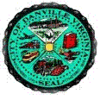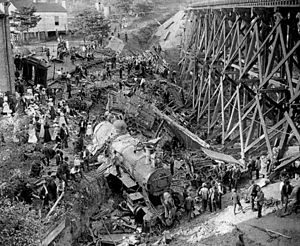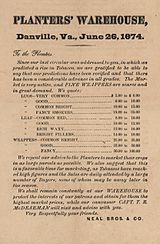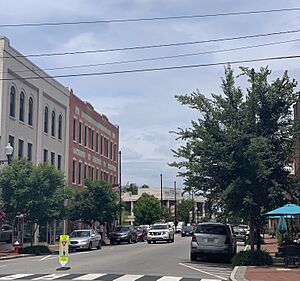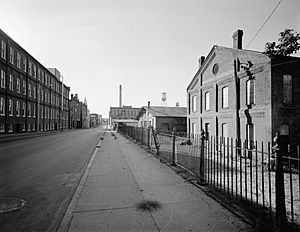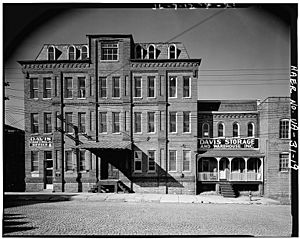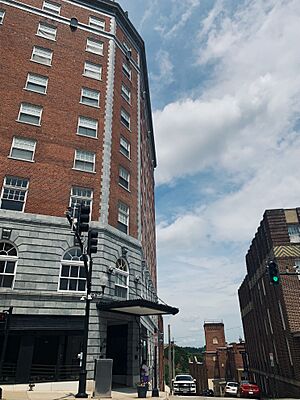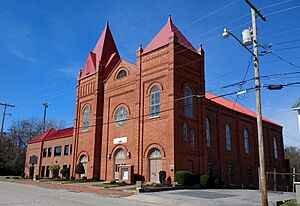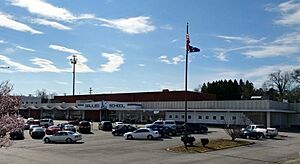Danville, Virginia facts for kids
Quick facts for kids
Danville, Virginia
|
|||||
|---|---|---|---|---|---|
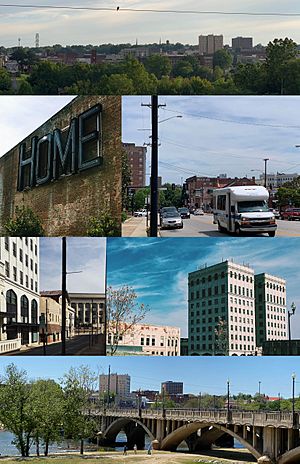
Worsham Street overlook, Main & Ridge St. intersection, Masonic building (River City Towers), Martin Luther King Jr. Memorial Bridge, municipal building from Union Street, repurposed Dan River Fabrics "Home" sign.(Clockwise from the top)
|
|||||
|
|||||
| Nicknames:
River City,
City of Churches, DanVegas, D'ville |
|||||
| Motto(s):
Reimagine That
|
|||||
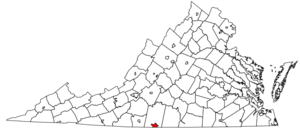
Location in the Commonwealth of Virginia
|
|||||
| Country | United States | ||||
| State | Virginia | ||||
| County | None (Independent city) | ||||
| Government | |||||
| • Type | Council–manager | ||||
| Area | |||||
| • Total | 43.70 sq mi (113.19 km2) | ||||
| • Land | 42.80 sq mi (110.84 km2) | ||||
| • Water | 0.90 sq mi (2.34 km2) | ||||
| Elevation | 531 ft (162 m) | ||||
| Population
(2020)
|
|||||
| • Total | 42,590 | ||||
| • Density | 974.60/sq mi (376.27/km2) | ||||
| Demonym(s) | Danvillian | ||||
| Time zone | UTC−5 (EST) | ||||
| • Summer (DST) | UTC−4 (EDT) | ||||
| ZIP Code |
24540-24541, 24543
|
||||
| Area code(s) | 434 | ||||
| FIPS code | 51-21344 | ||||
| GNIS feature ID | 1492837 | ||||
Danville is a city in Virginia, United States. It's called an independent city because it's not part of a county. Danville is located in the southern part of Virginia, right on the Dan River.
This city was once a big center for growing and processing tobacco. It also played an important role during the American Civil War. Because of its location on the Richmond and Danville Railroad, it was a key spot for the Confederacy. In April 1865, it even became the third and final capital of the Confederacy for a short time.
Danville is the main city in the Danville, Virginia Micropolitan Statistical Area. In 2020, about 42,590 people lived here. The city is next to Pittsylvania County and Caswell County, North Carolina. Danville is also home to the Danville Otterbots baseball team, which plays in the Appalachian League.
For a long time, Danville has had a majority African American population. After the Reconstruction era, African Americans had political representatives. Later, during the Civil Rights Movement, the city saw protests for equal rights.
Contents
History of Danville
Early Days and Native Americans
Long before Europeans arrived, many Native American tribes lived in this area. These tribes spoke Siouan languages.
In 1728, an English explorer named William Byrd explored the area. He was trying to figure out the border between Virginia and North Carolina. One night, he camped near what is now Danville. He loved the land so much that he imagined a future town there. He named the river the "Dan".
Founding of the Town
The first European-American settlement started in 1792. It was built downstream from Byrd's campsite, where the river was shallow enough to cross. It was first called "Wynne's Falls." The village grew from meetings of Revolutionary War veterans who met there to fish.
In 1793, a tobacco warehouse was built at Wynne's Falls. This was the start of Danville becoming a major tobacco market. The village was renamed "Danville" in November 1793. In 1833, James Lanier became the first mayor. By the mid-1800s, William T. Sutherlin, a local businessman, became a big name in the tobacco industry. He was the first to use water power for tobacco presses.
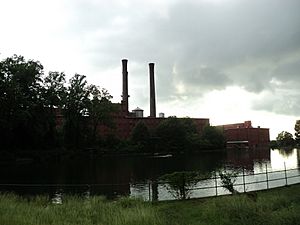
Several railroads, like the Richmond and Danville Railroad, came to Danville. This helped the city send its products, like tobacco, to other places.
Because of the river's waterfalls, Danville was a great place for factories that used water power. In 1882, the Riverside Cotton Mills opened. It later became known as Dan River Inc. and was once the largest single textile mill in the world. Today, the mill is closed. Many of its buildings have been taken down. "The White Mill," an important historic building, is now being turned into apartments.
A famous train crash happened in Danville on September 27, 1903. A fast mail train called "Old 97" was running late. It went too fast and crashed off a high bridge over the Dan River. Nine people died. This event was remembered in a popular song. You can find a historical marker and a mural in downtown Danville about this crash.
Over the years, changes in the tobacco, textile, and railroad industries caused many jobs to be lost in Danville. The city has been working hard to create new jobs and businesses.
Danville During the Civil War

When the Civil War began, Danville had about 5,000 people. During the war, it became a very important place for the Confederacy. Local businessman William T. Sutherlin helped manage supplies. The railroad was key for sending supplies to Confederate soldiers. A hospital was also set up for wounded soldiers.
Six tobacco warehouses were turned into prisons. At one point, they held over 5,000 captured Union soldiers. Sadly, many prisoners died from hunger and sickness. Their remains are buried in the Danville National Cemetery.
The Richmond and Danville Railroad was the main way supplies reached Petersburg, where General Lee's army was defending Richmond. Union cavalry troops eventually destroyed parts of the tracks.
Danville became the last headquarters of the Confederacy for a few days. Jefferson Davis, the Confederate President, stayed at William T. Sutherlin's mansion from April 3 to 10, 1865. He wrote his final Presidential Proclamation there. Davis and his cabinet left Danville when they heard that Lee's army had surrendered at Appomattox.
Civil Rights Movement in Danville
In the summer of 1963, there was a lot of activity in Danville for the Civil Rights Movement. For many years, most Black people in Virginia were not allowed to vote easily. Laws also kept Black and white people separate, known as Jim Crow laws.
On May 31, 1963, Black community leaders formed the Danville Christian Progressive Association (DCPA). They asked for an end to segregation and fair job opportunities in the city. They organized a boycott of white-owned stores and marched to City Hall.
Many of the marchers were high school students. Police and city workers met them with clubs and fire hoses. Many protesters needed medical help. Marches and protests continued for several weeks. Martin Luther King, Jr. visited Danville and spoke about the police actions. He said it was some of the worst police brutality he had seen in the South. One protest on June 10, 1963, became known as "Bloody Monday."
The Student Nonviolent Coordinating Committee (SNCC) sent people to help the DCPA. They helped lead protests, including at the Howard Johnson Hotel and restaurant, which did not serve Black customers or hire Black workers. A special jury charged many activists with breaking an old law from 1830. This law made it a serious crime to "incite the colored population to acts of violence or war against the white population." It was called the "John Brown" law because it was used to convict John Brown in 1859.
By the end of August, over 600 protesters had been arrested in Danville. The protests did not immediately end segregation in Danville. City places remained segregated until the Civil Rights Act of 1964 was passed. Black residents were able to vote more easily after the Voting Rights Act of 1965 was enforced by the federal government.
Geography
Danville is located near Virginia's southern border. It is about 70 miles (110 km) south of Lynchburg and 45 miles (72 km) northeast of Greensboro, North Carolina. You can reach it using U.S. Route 29 and U.S. Route 58.
The city covers about 43.9 square miles (113.7 km2) of land and water. Most of this is land, with about 1.0 square mile (2.6 km2) (2.3%) being water.
Climate
| Climate data for Danville, Virginia (Danville Regional Airport), 1981–2010 normals | |||||||||||||
|---|---|---|---|---|---|---|---|---|---|---|---|---|---|
| Month | Jan | Feb | Mar | Apr | May | Jun | Jul | Aug | Sep | Oct | Nov | Dec | Year |
| Mean daily maximum °F (°C) | 46.4 (8.0) |
50.1 (10.1) |
59.1 (15.1) |
69.8 (21.0) |
77.4 (25.2) |
84.7 (29.3) |
87.9 (31.1) |
86.3 (30.2) |
79.8 (26.6) |
70.0 (21.1) |
60.2 (15.7) |
49.6 (9.8) |
68.4 (20.2) |
| Mean daily minimum °F (°C) | 29.2 (−1.6) |
31.9 (−0.1) |
37.1 (2.8) |
45.3 (7.4) |
55.5 (13.1) |
65.1 (18.4) |
68.7 (20.4) |
67.9 (19.9) |
60.2 (15.7) |
49.0 (9.4) |
38.3 (3.5) |
30.6 (−0.8) |
48.7 (9.3) |
| Average precipitation inches (mm) | 3.42 (87) |
3.01 (76) |
4.11 (104) |
3.46 (88) |
3.88 (99) |
3.85 (98) |
4.59 (117) |
3.97 (101) |
3.96 (101) |
3.53 (90) |
3.36 (85) |
3.27 (83) |
44.41 (1,128) |
| Average snowfall inches (cm) | 2.2 (5.6) |
1.3 (3.3) |
.4 (1.0) |
.1 (0.25) |
0 (0) |
0 (0) |
0 (0) |
0 (0) |
0 (0) |
0 (0) |
0 (0) |
.5 (1.3) |
4.7 (12) |
| Average precipitation days (≥ 0.01 in) | 10.1 | 9.2 | 10.3 | 10.4 | 10.9 | 9.5 | 10.8 | 9.0 | 8.2 | 7.7 | 8.9 | 9.4 | 114.4 |
| Average snowy days (≥ 0.1 in) | 0.9 | 0.5 | 0.1 | 0.1 | 0 | 0 | 0 | 0 | 0 | 0 | 0 | 0.3 | 4.7 |
| Source: NOAA | |||||||||||||
People of Danville
2020 Census Information
| Race / Ethnicity | Pop 2010 | Pop 2020 | % 2010 | % 2020 |
|---|---|---|---|---|
| White alone (NH) | 20,107 | 16,884 | 46.70% | 39.64% |
| Black or African American alone (NH) | 20,725 | 21,733 | 48.14% | 51.03% |
| Native American or Alaska Native alone (NH) | 66 | 88 | 0.15% | 0.21% |
| Asian alone (NH) | 394 | 503 | 0.92% | 1.18% |
| Pacific Islander alone (NH) | 11 | 1 | 0.03% | 0.01% |
| Some Other Race alone (NH) | 33 | 143 | 0.08% | 0.34% |
| Mixed Race/Multi-Racial (NH) | 474 | 1,164 | 1.10% | 2.73% |
| Hispanic or Latino (any race) | 1,245 | 2,074 | 2.89% | 4.87% |
| Total | 43,055 | 42,590 | 100.00% | 100.00% |
Note: The US Census counts Hispanic/Latino people as an ethnic group. This means they are listed separately from racial categories, and people of Hispanic/Latino background can be of any race.
Economy and Businesses
Danville is home to several businesses and companies, including:
Swedwood, a company owned by IKEA, opened its first U.S. factory here in 2008. It employed over 300 people but closed in 2019.
Arts and Culture
The River District
Danville has been working to make its Historic Downtown and Tobacco Warehouse districts lively again. This area is now called "The River District." Many projects are underway to bring new life to this part of the city. See Danville River District.
Historic Areas and Homes
"Millionaire's Row" is a street with many large homes. These houses were built in the late 1800s and early 1900s by wealthy tobacco planters. The area has many trees and beautiful gardens.
Several parts of Danville are recognized as historic districts. These include Penn's Bottom, The Old West End, Tobacco Warehouse, Downtown Danville, Holbrook–Ross Street, and North Main.
The "Sutherlin Mansion" is also in a historic district. This grand home, built in the Italianate style, belonged to Major William T. Sutherlin. He was a big name in tobacco and banking. During the Civil War, he offered his mansion to Confederate President Jefferson Davis. Today, the mansion is the Danville Museum of Fine Arts and History.
Churches
Danville is sometimes called "the city of churches." It has more churches per square mile than any other city in Virginia.
Shopping
The Danville Mall, which used to be called Piedmont Mall, opened in 1984.
Sports
The Danville Braves were a minor league baseball team in Danville from 1993 to 2020. They were a farm team for the Atlanta Braves. They played their games at American Legion Field. In 2021, the league changed, and the Braves were replaced by the Danville Otterbots. This new team is for college baseball players who are just starting out.
Education
Schools in Danville
- Galileo Magnet High School
- George Washington High School
- Piedmont Governor's School for Mathematics, Science, and Technology
- O.T. Bonner Middle School
- Westwood Middle School
- Woodrow Wilson Intermediate School
- E.A. Gibson Elementary School
- Forest Hills Elementary School
- G.L.H. Johnson Elementary School
- Park Avenue Elementary School
- Schoolfield Elementary School
- Woodberry Hills Elementary School
Private Schools
- Westover Christian Academy
- Sacred Heart Catholic School
- Legacy Christian Academy
- Rivermont School Danville
Colleges and Universities
- Averett University
- Danville Community College
- Danville Regional Medical Center School of Health Professions
Media
Newspapers and Magazines
- Chatham Star Tribune (newspaper)
- Danville Register & Bee (newspaper)
- Evince (magazine)
- Showcase Magazine (magazine)
Radio Stations
- WAKG (103.3 FM)
- WBTM (102.5 FM)
- WDVA (1250 AM)
- WMPW (105.9 FM), known as MoreFM
- WWDN (104.5 FM)
Television Stations
Danville gets its TV channels from the Roanoke/Lynchburg area.
Transportation
Trains
Amtrak's Crescent train stops in Danville. This train connects Danville to big cities like New York, Philadelphia, Baltimore, Washington, Charlotte, Atlanta, Birmingham, and New Orleans. The Danville station was built in 1899 by Southern Railways.
Highways
U.S. Route 58 goes through Danville's main shopping area. There's also a US 58 Bypass that goes around the city center. U.S. Route 29 also has a business route that goes into downtown Danville and a bypass route.
Other important roads include:
- U.S. Route 360, which connects Danville to Richmond.
- U.S. Route 311, which now ends near Danville's western edge.
- North Carolina Highway 86 becomes State Route 86 when it crosses into Virginia.
- State Route 293 goes through Danville's downtown historic district.
- State Route 51 runs alongside US 58 Business.
Airport
The city also has its own airport, the Danville Regional Airport.
Notable People
- Nancy Astor, Viscountess Astor (born Nancy Langhorne), a famous politician in the British House of Commons.
- Barry Beggarly, a Short track race car driver.
- William Lewis Cabell, a Confederate general and mayor of Dallas.
- Buddy Curry, a player for the Atlanta Falcons football team.
- Wendy Dascomb, who was Miss Virginia USA in 1969 and Miss USA 1969.
- Terry Davis, a former professional basketball player in the NBA.
- Frederick Delius, a classical music composer.
- Ferrell Edmunds, an NFL football player.
- Robert H. Edmunds Jr., a justice on the North Carolina Supreme Court.
- Tremaine Edmunds, an NFL football player.
- Blind Boy Fuller, a blues guitarist and singer.
- Lee E. Goodman, a former Chairman of the U.S. Federal Election Commission.
- Emmet Gowin, a photographer.
- J. Hartwell Harrison, M.D., a doctor who helped with the world's first kidney transplant.
- Richard Benjamin Harrison, a star from the TV show Pawn Stars.
- John B. Henderson, a U.S. Senator from Missouri.
- Jules James, a Vice Admiral in the U.S. Navy during World War II.
- George M. La Monte, a paper manufacturer and philanthropist.
- Margaret Livingstone, a neurobiologist and professor at Harvard Medical School.
- Ralph Lowenstein, a journalism professor and dean.
- Percy Miller Jr., the first Black baseball player in the Carolina League.
- Jim Mitchell, an NFL football player for the Detroit Lions.
- Herman Moore, an NFL football player.
- Johnny Newman, an NBA basketball player.
- Mojo Nixon, a musician and radio host.
- Eric Owens, a former Major League Baseball player.
- John Wardlaw Paxton, D.D., a missionary to China.
- Timothy Peters, a NASCAR racecar driver.
- Nate Poole, an NFL football player.
- Tony Rice, a bluegrass musician.
- James I. Robertson Jr., a historian and professor.
- Gregory L. Robinson, director of the James Webb Space Telescope.
- Wendell Scott, the first African-American NASCAR driver.
- Peyton Sellers, a NASCAR driver.
- Charles Stanley, a pastor and founder of In Touch Ministries.
- Skipp Sudduth, an actor.
- William T. Sutherlin, a businessman and politician who hosted Jefferson Davis.
- Don Testerman, a professional football player.
- Charles Tyner, an actor.
- Ricky Van Shelton, a country music singer.
- Camilla Ella Williams, an opera singer, the first African American to sing with the New York City Opera.
- Andra Willis, a singer on The Lawrence Welk Show.
- David Wilson, a football player for the New York Giants.
- Robert E. Withers, a former Lieutenant Governor and U.S. Senator.
- Tony Womack, a Major League Baseball player.
Images for kids
See also
 In Spanish: Danville (Virginia) para niños
In Spanish: Danville (Virginia) para niños



